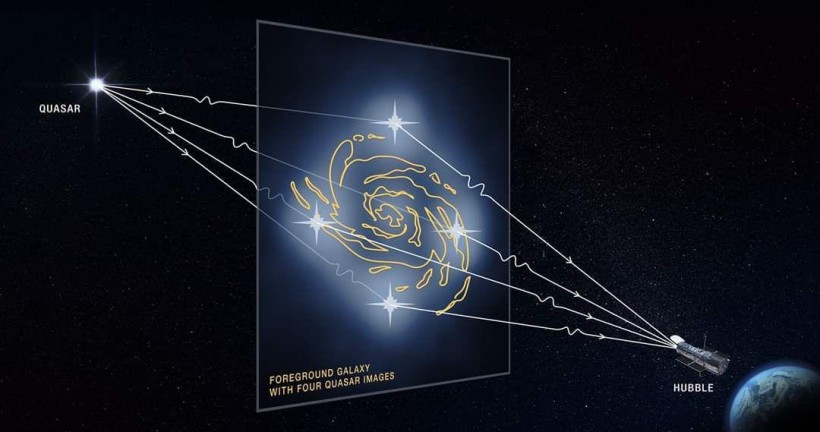Hubble makes a new breakthrough this week as it detects the smallest known dark matter clumps. Utilizing a new observing technique, astronomers and scientists discovered that dark matter forms much smaller clumps than what scientists previously thought - about 10,000 to 100,000 times smaller! This new discovery leans towards the "cold dark matter" theory.
In Existence, the regular matter (rocks, gases, plasma, and things we interact with) only make up about 5% of the universe. 25% of the whole universe consists of dark matter, and 70% is made up of dark energy. Both of which are invisible. This means that what we experience on a daily basis is really only a tiny fraction of reality. Dark matter is a mystery, and it doesn't reflect nor emit light.
In 1929, Edwin Hubble played a huge part in the discovery of Dark Energy, which makes up the rest of the 70% of the universe. Hubble calculated the redshifting of some of the galaxies. Later on, he concluded that the galaxies are moving away from each other. Recently it has been observed that the galaxies move at an accelerating phase, which means that the whole universe is actually expanding, in which actually, faster than the speed of light. This movement is fueled by some energy, which cannot be explained. Therefore, they coined the term "dark energy," and yes, it's not the same as "Dark Matter." Now 2020, the orbital telescope, which was named after him, has observed a new property of dark matter. Now we know that these dark matters are "colder" than we knew it.
Recently Hubble has just detected the smallest known clumps of Dark Matter. These recent findings confirm one of the major parts of the cold dark matter theory, which states that all galaxies form and are set within clouds of dark matter. And dark matter is made of cold or slow-moving particles to form structures with wide ranges in mass.
Anna Nierenberg of NASA's Jet Propulsion Laboratory in Pasadena, CA and a leader of the Hubble survey stated:
"Dark matter is colder than we knew at smaller scales. Astronomers have carried out other observational tests of dark matter theories before, but ours provide the strongest evidence yet for the presence of small clumps of cold dark matter. By combining the latest theoretical predictions, statistical tools and new Hubble observations, we now have a much more robust result than was previously possible."
Hunting for dark matter concentrations devoid of stars is no easy task. Recently the Hubble research team has utilized a different technique wherein they did not look for the gravitational influence of stars as tracers of it. They targeted 8 distant quasars which acted like cosmic "streetlights". These are regions around active black holes and they emit a large amount of light. They measured the manner of which the light emitted by O2 and neon gas each of the quasars' black holes is warped by the gravity of a massive foreground galaxy, which served as some sort of magnifying lens.
This method helped unveil dark matter clumps along Hubble's line of sight to the quasars including in and around the intervening lensing Hunting for dark matter concentrations devoid of stars is no easy task. Recently the Hubble research team has utilized a different technique wherein they did not look for the gravitational influence of stars as tracers of it. They targeted eight distant quasars that acted like cosmic "streetlights." These are regions around active black holes, and they emit a large amount of light. They measured the manner of which the light emitted by O2 and neon gas each of the quasars' black holes is warped by the gravity of a massive foreground galaxy, which served as some sort of magnifying lens.
This method helped unveil dark matter clumps along Hubble's line of sight to the quasars, including in and around the intervening lensing galaxies. These dark matter concentrations that Hubble detected are 10000-100000 times smaller than the mass of Milky Way's dark matter halo. Much of these tiny groupings most probably don't contain even small galaxies and would have been impossible to observe by the more traditional method of looking for embedded stars. galaxies. These dark matter concentrations that Hubble detected are 10000-100000 times smaller than the mass of Milky Way's dark matter halo. Much of these tiny groupings most probably don't contain even small galaxies and would have been impossible to observe by the more traditional method of looking for embedded stars.

Smallest clumps of dark matter detected recently by Hubble telescope using the latest observation method
This is the NASA article for further reading. There they explain the full method they used and explained it in depth.
The findings will be presented at the annual American Astronomical Society meeting. Bookmark the page for more tech updates!









